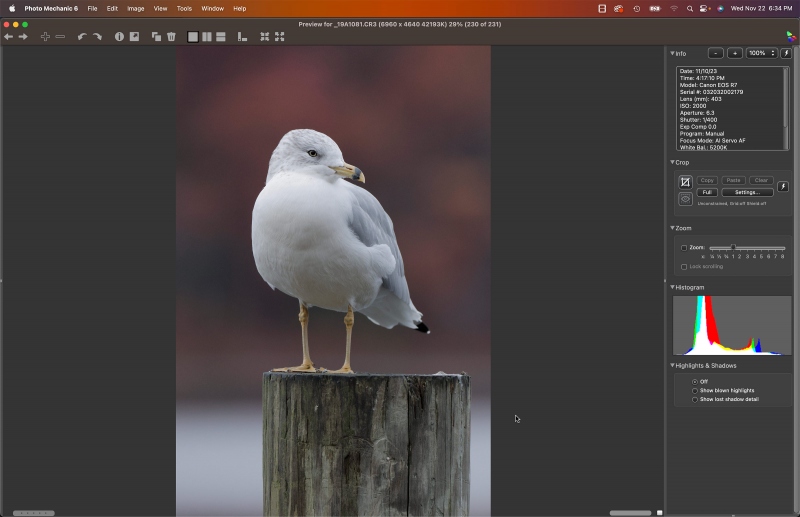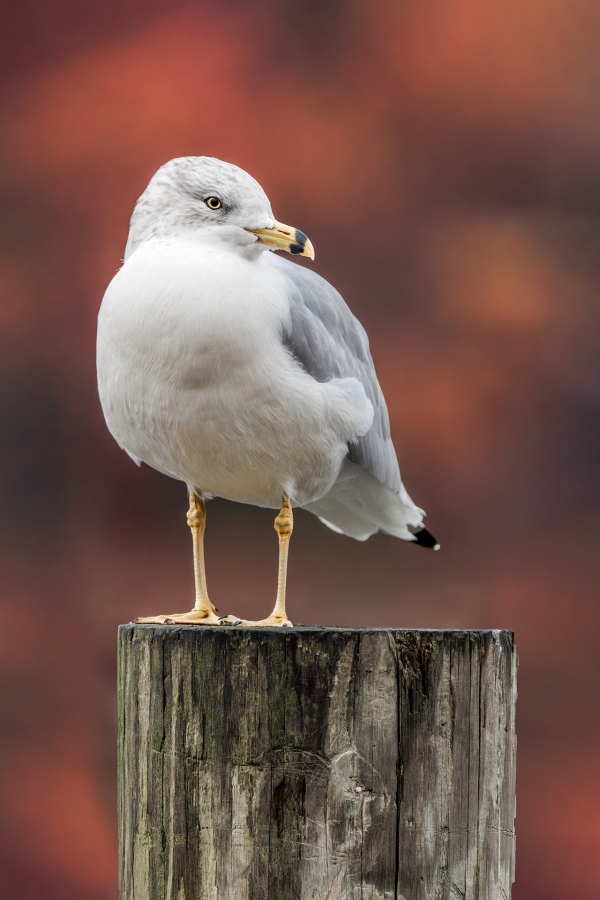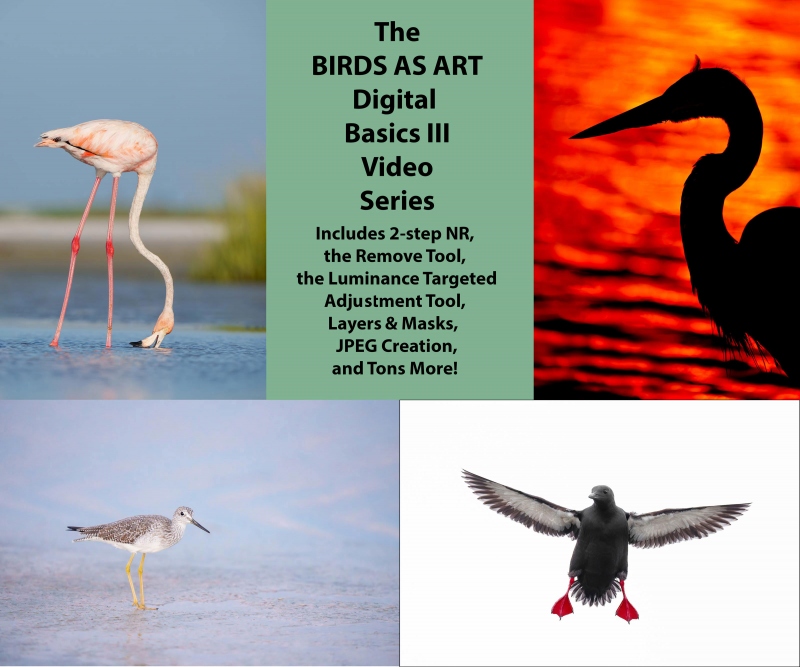David Policansky. November 20, 2023 at 10:44am:
I got the reference to the song, one of my favorites, immediately. Well done. Making photographic images is increasingly manipulating computers. I still like the physical, mechanical aspects of photography, and miss some of them. I tried to photograph Jupiter last night with my new Canon R7 but I couldn’t find it in the EVF, so I had to use my 7D2 with its beautiful bright OVF.
Arthur Morris/BIRDS AS ART. November 22, 2023 at 6:27am:
Hi David,
Thanks for enjoying my reference to “Don’t It Make My Brown Eyes Blue.” Not sure about your problems finding Jupiter other than to say that the brightness of EVFs is controlled by the exposure settings.
re:
“Making photographic images is increasingly about {sic} manipulating computers.”
With digital, the photographer get to control how his or her images look. With film, that was the job of the lab. I far prefer the former, in fact, for me, processing images is one of the great joys of digital photography.
with love, artie
Furthermore …
I see the raw files that I create simply as digital negatives, to be developed and enhanced as I see fit. With the Turkey Vulture white sky image featured in the previous blog post, by properly exposing far to the right, the blue in the sky was in the raw file, waiting to be enhanced.
As for me, I wish that I had never heard the word “film.”
Your Call?
If you used film and switched to digital as many of us did, which do you prefer, and why?
What’s Up?
After checking the weather for Vero Beach on Monday evening, I got excited. The forecast was calling for 15-20mph winds from the southeast, perfect for Sebastian Inlet. Jim and I woke early and arrived at the State Park at 6:40am. The wind and sun were aligned perfectly. There were dozens of Ospreys in the air fishing. There were two problems. The only birds catching anything were south of the south jetty, backlit and flying away. Crossing the bridge, I found that the birds hunting above the Northwest Pool were fishing but not diving and thus not catching. Though almost everyone photographing at Sebastian has eyes only for Osprey, there are many other birds to photograph. I had a great morning doing flight and action (flapping after bathing) photography; subjects included Royal and Caspian Tern, an adult Lesser Black-backed Gull, juvenile Herring Gull, first winter Laughing Gull, Brown Pelican, Great Egret, Snowy Egret, Wood Stork, Willet, and Ruddy Turnstone. I considered returning on Wednesday morning but slept in once I saw the forecast for a strong SW wind. Winds from the east and/or the south have been rarer than hen’s teeth on both central Florida coasts this fall.
Today is Thursday 23 November 2023. Enjoy the football and the food and try not to eat too, too much. Though the forecast is calling for partly cloudy skies with a light NW breeze (far less than ideal), I will head down to the lake for a bit.
Wherever you are a whatever you are doing, I hope that you too have a great day.
Please remember to use the B&H and Amazon links that are found on most blog pages and to use the BIRDSASART discount code at checkout when purchasing your new gear from Bedfords to get 3% back on your credit card and enjoy free second-day air FedEx. Please, also, consider joining a BAA IPT. You will be amazed at how much you will learn!
You can find some great photo accessories (and necessities, like surf booties!) on Amazon by clicking on the Stuff tab on the orange/yellow menu bar above. On a related note, it would be extremely helpful if blog-folks who, like me, spend too much money on Amazon, would get in the habit of clicking on the Amazon logo link on the right side of each blog post when they shop online. As you might expect, doing so will not cost you a single penny, but would be appreciated tremendously by yours truly. And doing so works seamlessly with your Amazon Prime account.
If an item — a Delkin flash card, or a tripod head — for example, that is available from B&H and/or Bedfords, is also available in the BAA Online Store, it would be great, and greatly appreciated, if you would opt to purchase from us. We will match any price. Please remember also to use my B&H affiliate links or to earn 3% cash back at Bedfords by using the BIRDSASART discount code at checkout for your major gear purchases. Doing either often earns you free guides and/or discounts. And always earns my great appreciation.
|
|
Image #1: Ring-billed Gull image by Dave Goldberg |
The Raw File
I came across Dave Goldberg’s Ring-billed Gull image in the Avian Forum at Bird Photographers.Net.
You can see Dave’s original post, several excellent comments, and several reposts in the thread here.
Everyone agreed that the image was processed too dark and that that the white balance was off. I asked, and Dave kindly sent me the raw file. The Photo Mechanic histogram above shows significant underexposure. Evaluating the raw file in RawDigger, however, revealed that the exposure was perfect, only 1/3-stop from dead solid prefect.
|
|
The BIRDS AS ART Current Workflow e-Guide (Digital Basics II).You can order your copy from the BAA Online Store here, by sending a PayPal for $40 here, or by calling Jim or Jennifer weekdays at 863-692-0906 with your credit card in hand. Be sure to specify Digital Basics II. |
The BIRDS AS ART Current Workflow e-Guide (Digital Basics II)
The techniques mentioned above and tons more great Photoshop tips and techniques — along with my complete digital workflow, Digital Eye Doctor Techniques, and all my personalized Keyboard Shortcuts — are covered in detail in the BIRDS AS ART Current Workflow e-Guide (Digital Basics II), an instructional PDF that is sent via e-mail. Note: folks working on a PC and/or those who do not want to miss anything Photoshop may wish to purchase the original Digital Basics along with DB II while saving $15 by clicking here to buy the DB Bundle.
Please note: the Divide and Conquer technique was inadvertently omitted from DB II. It is detailed in a free excerpt in the blog post here.
Folks who learn well by following along rather than by reading can check out the complete collection of MP 4 Photoshop Tutorial Videos by clicking here. Note: most of the videos are now priced at an amazingly low $5.00 each.
You can learn how and why I converted all of my Canon digital RAW files in DPP 4 in the DPP 4 RAW Conversion Guide here. More recently, I became proficient at converting my Nikon RAW (NEF) files in Adobe Camera Raw. About three years ago I began converting my Nikon and Sony RAW files in Capture One and did that for two years. You can learn more about Capture One in the Capture One Pro 12 Simplified MP4 Video here. The next step would be to get a copy of Arash Hazeghi’s “The Nikon Photographers’ Guide to Phase One Capture One Pro e-Guide” in the blog post here. Today, I convert my Sony raw files in Photoshop with Adobe Camera Raw.
You can learn advanced Quick Masking and advanced Layer Masking techniques in APTATS I & II. You can save $15 by purchasing the pair.
|
|
Image #2: Ring-billed Gull on post. Image courtesy of and copyright 2023: Dave Goldberg. |
Optimizing the Image
I used click White Balance and went to work. I set the sliders in the Colors, Light, and Effect panels as per my DB III workflow. I used my recently developed two-step noise reduction technique and the new Remove Tool for a bit of image clean-up mainly on the wooden post and the bird’s bill. The Luminance Targeted Adjustment Tool (L-TAT) did a great job of brightening the background and the gull’s bill. The most difficult part of the image optimization for me was getting rid of the water. I used a series of Quick Masks refined by regular Layer Masks, the Patch Tool, and the Clone Stamp. The background was smoothed with a layer of Gaussian Blur refined by a Hide-All (Inverse or Black) Layer Mask.
Finally, I used Content-Aware crop to level the image and add room above and left.
|
|
The Digital Basics III Video Series |
The Digital Basics III Video Series
I realized about a year ago that my digital workflow had changed significantly and was toying with the idea of writing a Digital Basics III. More recently, I have learned and begun working with two great new Photoshop Tools, the Remove Tool and the Luminance Targeted Adjustment Tool. The former is like a smarter Spot Healing Brush Tool on steroids and the latter is a huge step up from the fabulous Color Mixer Tool. During that same time frame, I came up with a new and improved 2-step noise reduction technique. I still use Divide and Conquer, Quick Masks, Layer Masks, an expanded array of personalized keyboard shortcuts, and tons of other stuff from both versions of Digital Basics.
As soon as I realized that I did not want to take on another large writing project, I realized that by creating a series of videos I could much more easily share all the details of my current digital workflow and much more easily incorporate additional new tips, techniques, and tools as I went. And so, The Digital Basics III Video Series was born. You can check out Volume I/#1 here.
You might opt to purchase single videos or to subscribe to Volume I and save $26 by ordering the first five videos in one fell swoop. You can purchase the five videos in Volume I by clicking here. The videos will be most valuable for folks using the latest version of Photoshop (2024) or Lightroom along with Topaz DeNoise AI and Topaz Sharpen AI.
Typos
With all blog posts, feel free to e-mail or to leave a comment regarding any typos or errors.


















Hi all, Happy Turkey Day.
Shot film for about 40 years until moving to digital around 2002 or so.
Processed my own B&W but shot a fair amount of slides, too.
Not going back to film. It’s too expensive, too slow, and not all that good for the environment (darkroom chemistry). It was fun, I enjoyed it, but digital is where I am now. I do however, have a box / roll of Kodachrome displayed in my office (expiration date 1983).
Be well out there, and keep shooting.
Thanks! I agree. I once put 500 rolls of Fuji Velvia into the garbage can and saved the film canisters for my supplements!
with love, artie
Absolutely beautiful optimization of the gull.
No more going back to film for me either. I am a much better photographer with being able to see the images, especially on my computer the same day. Bringing out the best in them on the computer is very satisfying too. And all the camera improvements make photographing a lot more fun–more creative ways to experiment with.
Thanks and agree 100%!
with love, artie
Hi Artie. Happy Thanksgiving to you and all your blog followers. I started processing and printing b&w film in the garage in the mid-1960s. I never had a film exposure as good as what I now consistently achieve with my Sony a1s set up per your a1 guide. I even had the opportunity in the 1990s to be ringside for a Mayweather bout with 2 film cameras slung over the shoulders. Sure wish I had today’s technology then. I don’t have any desire to go back to film. I also firmly believe that if Ansel Adams was still with us that he would embrace digital photography as much as you do. For Ansel the goal was the image end point, the final image, not the technology used to achieve it. After all, Ansel was one of the early consultants to Polaroid (developing such as the Type 55 that produced both a print and negative). No, digital photography is not phony, it is a means to an end, producing a fine art image/print.
Hey Dane,
Thanks for your interesting comment. I share your views.
with love, artie
Image #1 and #2 Ring-billed Gull are interesting and good but Image #2 is closer and bigger!
I began with film and had perhaps 5,000 keeper slides before making the transition to digital. When I began scanning my slide collection I only scanned a small handful as anything I photographed digitally far surpassed the transparency. I love digital. When I go for a swim with the turtles I can often shoot upwards of 800 frames. If I was shooting film this would have required me to leave the the water roughly 22 times to change rolls of film, assuming 36 exposures per roll.
Thanks, Andrew. Do they have turkeys on Grand Cayman?
I have had 5000+ image sessions in Homer, and one guy with an R5v shot 25000 frames in a single morning with the eagles!
with love, a
Turkeys are only found in the grocery store on Grand Cayman 🙂
Thanks, Andrew. I was not sure of that 🙂
with love a
Good morning and happy Thanksgiving, Artie. “Phony” is your word, not mine! Yes, of course I prefer digital to film and would never willingly go back to using film. And of course I enjoy enhancing my images at the computer. Primitive though my my skills are, I still sometimes making a silk purse out of a pig’s ear. But sometimes I worry that the skills and pleasures of framing, exposure, choosing backgrounds, etc. get overlooked in favor of post-processibg, although not by you, who taught me much in those departments. And despite the convenience of an EVF, I still prefer the clarity of an OVF. By the way, if I make Jupiter bright enough to find in the EVF, then I am overexposing. How do I solve that problem?
Hi David, Canon doesn’t emphasize astrophotography unlike Nikon. In fact, Nikon has a high gain EVF setting (along with red light menus) to facilitate item localization and focusing. If you’re having difficulties locating Jupiter (which is surprising BTW because it is around -2.5 so easily visible to the naked eye in cities) then dial up your exposure to initially visualize it in your EVF, set your focus, hit the MF/AF switch to MF, dial back your exposure to proper levels and fire away.
Thanks, Adam. I am handholding the camera with a long lens so I probably won’t be able to pull that off.
David, Handholding for astrophotography makes zero sense to me …
with love, artie
Though I never do either, Sony mirrorless as I understand it is terrible for night and astrophotography. I go to bed early 🙂
a
Artie
If i recall i did pretty darn good in Homer at night while you slept. 🙂 The Aurora was amazing!
Happy Thanksgiving Sir.
Anyone looking for an amazing time get to Homer there is so much to see and not to mention hundreds and hundreds of Eagles so close and to see them up close and personal like that is truly something to behold, portraits are a given and flight and you name it its there.
Always with love b
Using Bright spot monitoring on Sony does the amazing and lights up the sky!
Like Zebras it is cheating, got to love it.
Always with love b
I used black and white film for a while in the 80’s ….. even made my own film rolls and had a darkroom for producing black and white prints. I enjoyed experimenting with different films, paper and darkroom techniques ….. also used color film too but used a commercial lab for prints. I concur with you …. happy that film is mostly in the past and really enjoy the advantages and creativity that digital processing affords. Happy Thanksgiving!
Thanks, Joel. And ditto on the turkey day good wishes.
a
Digital photography too phony? My opinion is it can be, but it doesn’t have to be. It’s up to the photographer and I won’t judge someone else’s choices. Todays digital cameras are incredible tools. I can’t imagine going back.
Thanks and nice seeing you here.
a